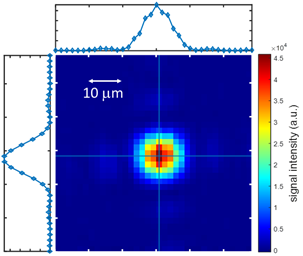(English follows Dutch)
SPEXone, het Nederlandse instrument aan boord van NASA’s PACE-missie, heeft zijn ‘First Light’ mijlpaal bereikt. Airbus DS NL en SRON ontwikkelen SPEXone om aerosolen in de atmosfeer te analyseren.

First Light markeert een kleine stap richting een volledig functionerend instrument, maar wel een belangrijke. Om deze mijlpaal in het ontwikkelingstraject van SPEXone te bereiken, hebben de onderzoekers een lichtbron op de detector gericht en zijn ze erin geslaagd om het eerste scherpe beeld uit het instrument te toveren. Dat is minder eenvoudig dan het lijkt, omdat ze een aantal spiegels nauwkeurig moeten uitlijnen, met een zijwaartse foutmarge van 20 micrometer (dikte van een mensenhaar) en een rotatiefoutmarge van 20 boogseconden (1% van de volle maan). Dit is nodig om de lichtstraal door minieme openingen te sturen zonder dat er licht uit andere richtingen binnenkomt. De resultaten zijn veelbelovend; het beeld toont een scherpe en heldere vlek van 10 micrometer breed. De volgende stap is het toevoegen van de spectrometer—een complex prisma—om een regenboog te produceren.
SPEXone is een compact optisch instrument dat aerosolen in de aardatmosfeer gaat karakteriseren vanuit een lage baan om de aarde. Het maakt deel uit van NASA’s PACE-missie (lancering in 2023), als een partnered payload. SPEXone wordt ontwikkeld door een samenwerking tussen SRON Netherlands Institute for Space Research en Airbus Defense and Space Netherlands. TNO biedt ondersteuning bij optische aspecten van het ontwerp en produceert de speciale vrije-vorm spiegels.
Aerosol space instrument SPEXone sees first light
SPEXone, the Dutch instrument onboard NASA’s PACE mission, has reached its ‘First Light’ milestone. Airbus DS NL and SRON develop SPEXone to analyse aerosols in our atmosphere.

First Light marks a small step towards a fully functional instrument, but an important one. To reach this milestone in the development trajectory of SPEXone, the engineers pointed a light source at the detector and managed to obtain the first sharp image. This is not trivial, because a number of mirrors have to be aligned accurately, with a sideways error margin of 20 micrometer (width of a human hair) and a rotation error margin of 20 arcseconds (1% of a full moon). This is necessary to get the light beam through very small openings without any light coming in from other directions. The results are promising; the image shows a sharp and bright spot of 10 micrometer wide. The next step will be adding the spectrometer – a complex prism – and produce a rainbow.
SPEXone is a compact optical instrument to characterise aerosols in the Earth’s atmosphere from low Earth orbit. It is part of the NASA PACE mission (to be launched in 2023), as a partnered payload. SPEXone is developed in a partnership between SRON Netherlands Institute for Space Research and Airbus Defence and Space Netherlands. TNO provided support for optical aspects of the design, and the manufacturing of the free-form mirrors.


